Damien Thaller has over 20 years of experience in visual effects. He has worked in many studios like ILM, Rising Sun Pictures, Image Engine before joining FuseFX in 2020. He has worked on projects such as Logan, Lost in Space, Fantastic Beasts: The Crimes of Grindelwald and Game of Thrones.
What is your background?
I’ve been creating art since I could hold a pencil. I originally studied traditional art & design while working in the gaming industry in the 90’s with a focus on character & vehicle design. The gaming industry back then was very exciting transitioning from PC to early PlayStation & XBox consoles, here I shifted and broadened into a more 3D environment that led me to film. In film I fell into the world of creating environments with matte paintings & 3D builds. Through my time as an artist I shifted into VFX art direction & supervisor roles in film and episodic.
How did you and FuseFX get involved in this series?
Jon Cowley, the FuseFX head of Studio, had an excellent working relationship with Darren Bell, the VFX producer that brought the show into the studio for season 1. I had worked with Jon in the past, and I was wrapping the last season of Game of Thrones as well as Joker when Jon and I began chatting about coming onboard as VFX supervisor for Snowpiercer Season 2. The timing was good, I met the team and we went from there!
How was the collaboration with the showrunners, directors and VFX Supervisor Geoff Scott?
Showrunner and producer Graeme Manson and director Christoph Schrewe work very closely with Geoff Scott & Darren Bell. They would be heavily part of all our reviewing process giving us feedback weekly, almost daily sometimes at the speed we were moving. There were times when we would be crossing over and working on 5 episodes at one time so the collaboration had to be really clear and tight. I had a great relationship with Geoff, so apart from the formal review channels we would also call each other and talk where needed quite often. This was perfect when I required answers on something or instant clarification, and we would just jump onto a call together and go over it. We worked like this over all the season 2 episodes talking about all things story focused and creative. Geoff was always available which was great.
What was his approach and expectations about the visual effects?
Something we spoke about from day one was the visual effects needed to be grounded in the real world. For example, if this ice age had really happened what would it look like technically and how would the world’s environment react. Referencing frozen areas of the real world were common conversations throughout, and for instance, vegetation would not survive anywhere under these cold conditions. In fact, trees and forests would fossilize and perish to nothing. We worked very closely with Geoff on concept art and Previz to establish the shot design required for the story well before we went into shot work. The approach visually was really keeping it true to realism.
How did you organize the work with your VFX Producer?
We had an amazing production team that worked very closely with client side VFX Producer Darren Bell. Tyler Kehl, our VFX producer, is amazing. He would be looking ahead and working very closely with Darren. There’s a real art in connecting all the dots when you’re working on various episodes at once with crossing over deliveries. I would look at the scope of work, do my initial creative pass, then Tyler and I would go over it together, break it apart and make it all fit.
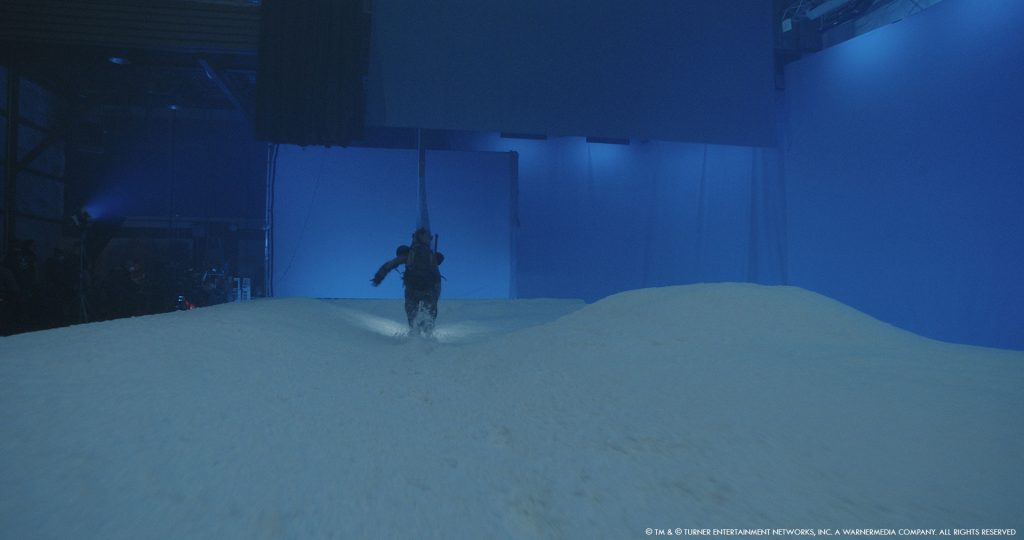
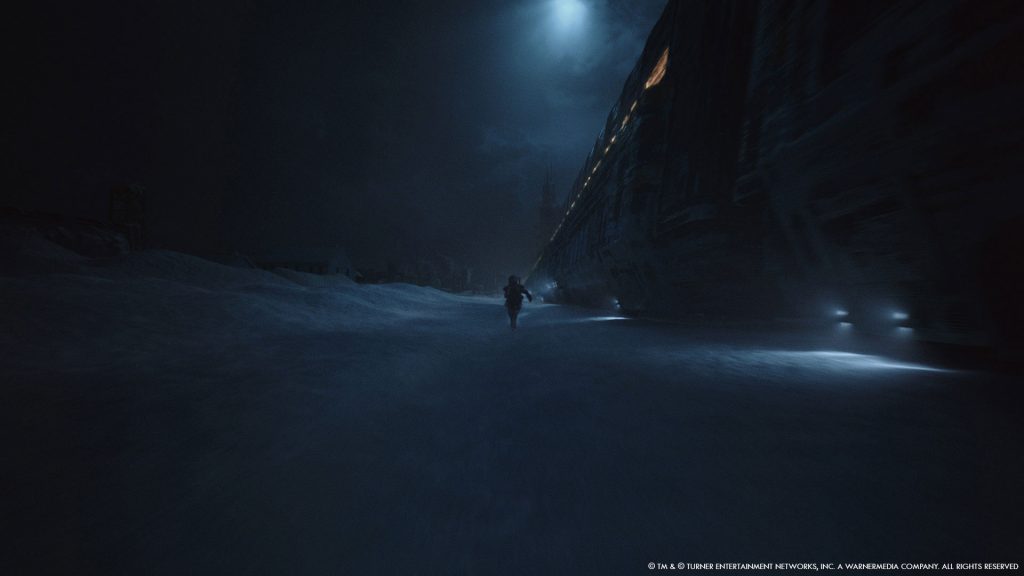
How was the work split amongst the FuseFX offices?
The bulk of the team and work was all done out of the Vancouver studio. Although we did have some help from the LA office. FuseFX does a very good job sharing their production and artist resources across all offices. Strategically, scaling our team when required was key. If a particular episode required more artists in a particular department our production managers did a stellar job sharing them from other offices instead of hiring. For example, LA offices have some amazing senior lighters that we were able to throw some work from time to time that worked in our benefit. We kept all of the compositing together in Vancouver.
Did the production want to change anything on the VFX side since the first season?
Yes, more VFX! In the first season we get a peek of what’s outside the train, as most of the story was contained to inside. In season 2 we venture out from the train many times. We were able to elaborate more on the frozen world beyond the train, and the VFX played a more substantial role in supporting the story. There are a few sequences we see outside the trains that would not have been possible to shoot anywhere or in a studio to achieve what we did with the train moving at such high speeds.
Can you explain in detail about the creation of the two trains?
The train designs were established in season 1 by concept designer Alex Nice with Geoff Scott. Snowpiercer is a pulling engine with 1001 cars and up to 2 stories in height. The Big Alice train is a pushing engine and is up to 3 stories in height. I believe the designs were partially influenced by various real world trains.
Can you tell us more about the shaders and textures creation?
The world of Snowpiercer is an ice age. Everything is frozen and covered by snow. Right from the start, we knew that it was essential for us to establish a pretty comprehensive shader and texture library. We already had established the trains from season one and needed to do the same for the environments and asset set props for season 2. Our CG supervisor Sean Ritchie and team worked on creating these shaders to work in different lighting situations using VRay. We were creating a visual mix of ice and snow, not the fresh powder wonderland type of snow. Creating these libraries gave us the ability to work smarter and faster when beginning new episodes. We did create some bespoke train textures and lighting for the opening Chicago City rail yard scenes in the first episode of season 2 where we see Melanie so close to the trains.
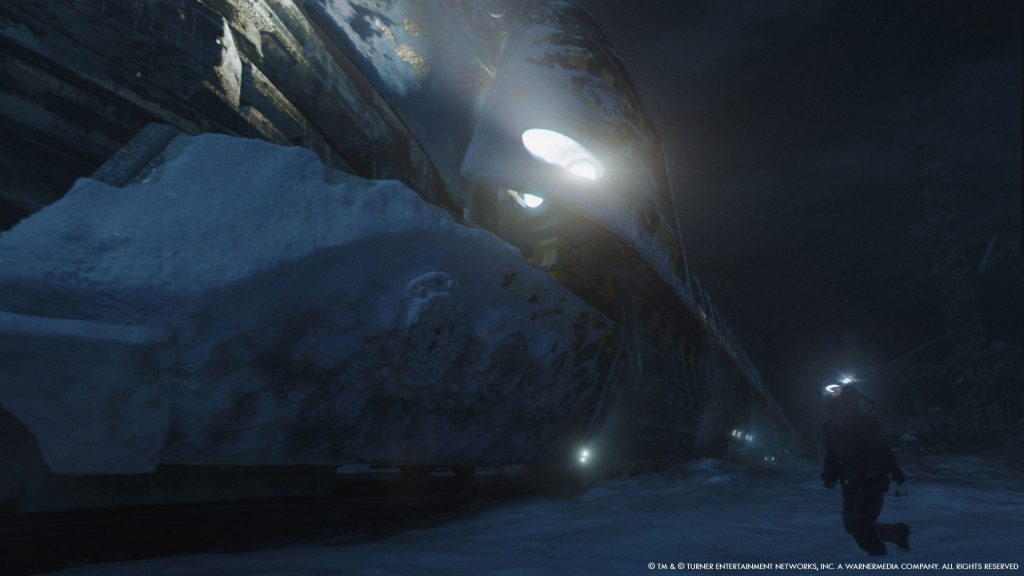
Did you use procedural tools for the train and its train cars?
The train’s procedural textures were created by Geoff Scott with another vendor at the beginning of season 1. We ingested these into our pipeline and created bespoke setups where needed for specific shots. We built tools that help us quickly and smoothly transfer our train cars from Previz/layout into shot build. These tools evolved over season 2 and helped us become more efficient at streamlining our shot build work.
Can you tell us more about the FX work on the snow and ice?
Our FX team did a stellar job with adding the glue here so the trains look and feel grounded into the environments. FX produced simulations for the trains when they plow through snow as well as atmos simulations. We also used FX simulations for icicles attached to environment structures that would break when trains pass. There were also multiple simulations for general snow in the air wrapping around the trains and sweeping off mountain peaks. Many bespoke sims were created for one off shots of fog freezing effects and steam omitting from the trains. Brody Fikkert, our FX TD, established a pretty good comprehensive sim library of renders over the 2 seasons that comp were able to quickly choose when lookdeving shots in Nuke for general passing anomaly snow.
What was your approach to create the huge frozen world?
It was led by creative! I looked at real world photo references and video footage then began mapping out concept art to get conversations happening with Geoff and the showrunners. My team and I together would be looking at references daily breaking down why something looks and acts in a particular way. Once we were all happy with the look and direction, Frank Belina, our Layout Previz supervisor, would take the art and jump into cameras and blocking. We tried something new using GAEA, a procedural terrain builder that was new to our pipeline. We took the lessons we learned in season 1 and figured out a faster way for mass creation of environments. GAEA was our answer. Our lighting & lookdev artists then could export these landmasses into shot, and work on refinement and dressing into their specific shots with props and train interaction. GAEA was a very quick tool for us to implement into our pipeline where then our lookdev artists would pick up. Besides the FX atmos simulations, our DFX supervisor, Henrique Moser, created a very cool library of procedural snow, motes and mist pocket setups that lived in Nuke. Compositing could then use these scripts to populate the levels of atmos required per episode into our shots. Establishing good references, concepts and key art in combination with our library setups were key to our workflow.
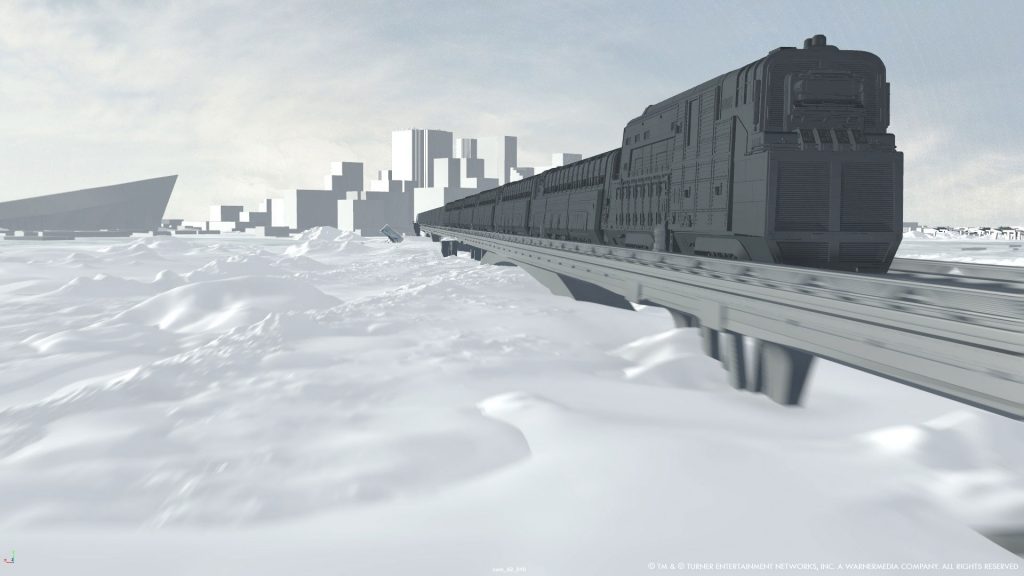
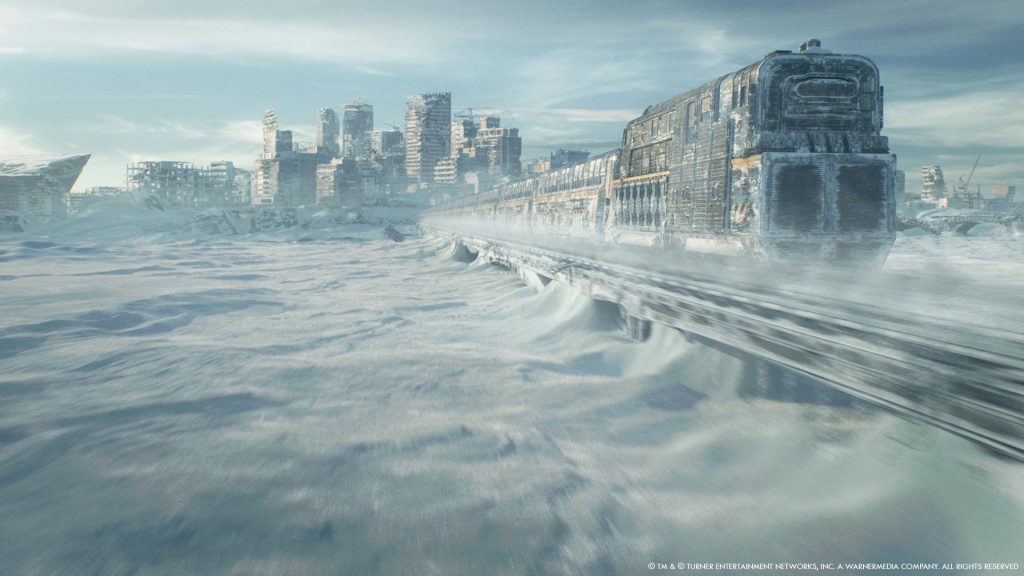
How does the frozen world and the sequences by night affect the lighting work?
It hugely affects it. Snow at night technically has a very different look about it than in the daylight. It’s much brighter with a particular visual glow to it. We spent some time lookdeving this until we created the look we were happy with.
Which sequence or shot was the most challenging?
In a later episode we see exterior wide views of the trains traveling down and around a canyon corkscrew at night. It was a technical challenge to place so many cars at one time into the shots. But after many conversations with some great minds the end result was less scary than we initially thought.
Did you want to reveal any other invisible effects?
There are many, for instance some of the interior work of the trains is extended. The set design is brilliant, and we kept the look and extended some of the car interiors.
Is there something specific that gives you some really short nights?
Excitement when it all comes together!
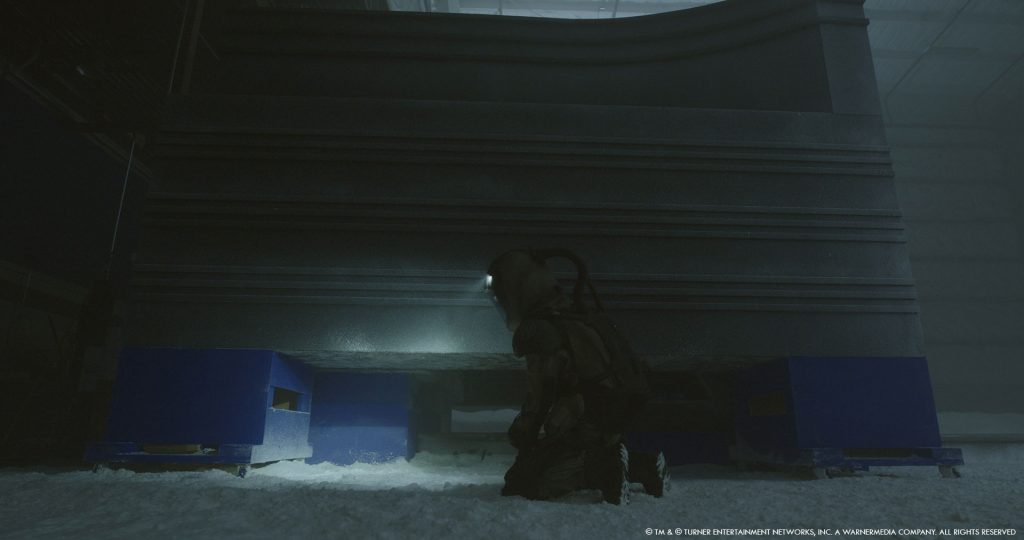
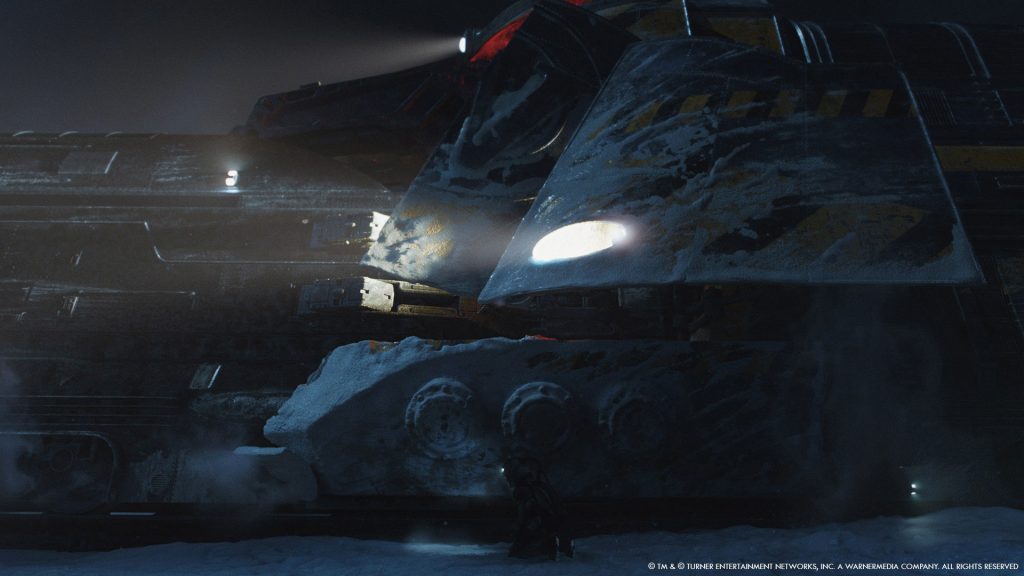
What is your favorite shot or sequence?
There are a lot, but one of them is the Vista shot establishing the frozen city of Minneapolis. Also, the opening sequence in episode 1 season 2 with Melanie. I also loved a sequence later in around episode 7 where we see a dangerous story beat where something happens to the exterior of the train.
What is your best memory on this show?
Besides all the amazing and talented people I met and worked with that come from different corners of the world, it’s when all our hard work comes together. It’s amazing getting to see something and thinking wow that’s pretty sweet, this is what we’re here for!
How long have you worked on this show?
1 year and 1 month.
What’s the VFX shots count?
Around 500 shots.
What was the size of your team?
A tight elite team of around 50.
What is your next project?
Unfortunately, it’s too early to talk about it because of confidential reasons.
What are the four movies that gave you the passion for cinema?
Jason and The Argonauts
The Empire Strikes Back
Raiders of The Lost Ark
John Carpenter’s The Thing
A big thanks for your time.
WANT TO KNOW MORE?
FuseFX: Dedicated page about Snowpiercer – Season 2 on FuseFX website.
© Vincent Frei – The Art of VFX – 2021




